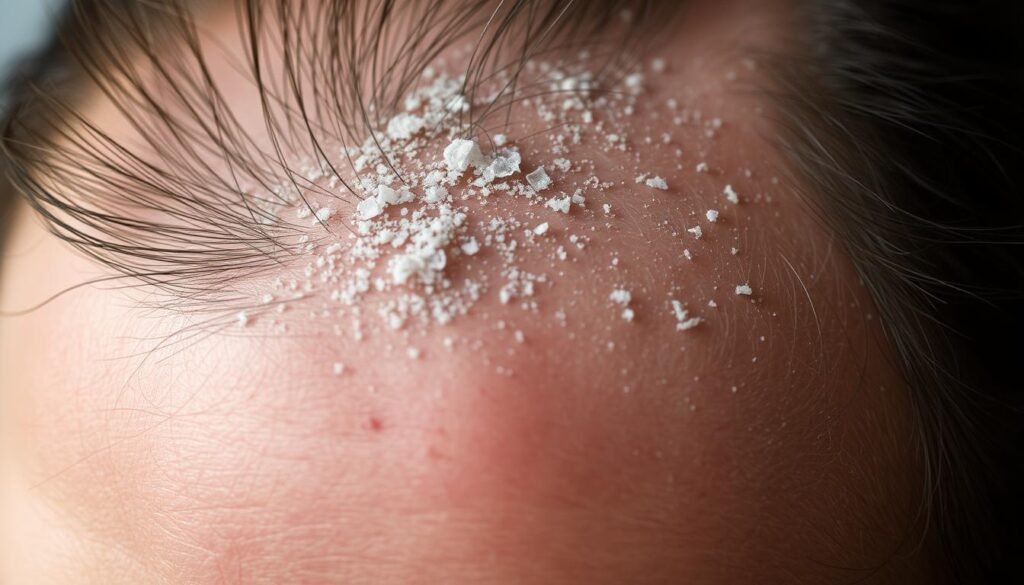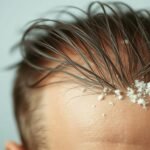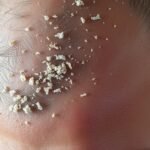Are you wondering if you should wash your hair every day if you have dandruff? Dandruff and hair washing frequency are closely related. Understanding this can help you find relief from dandruff. The American Academy of Dermatology suggests washing hair two to three times a week for optimal scalp health and dandruff relief. But what’s the best approach for you? Should you wash your hair every day if you have dandruff, or is that too frequent?
Key Takeaways
- Washing your hair every day can lead to dryness, breakage, and frizz, which is bad for curly or dry hair.
- Experts say washing hair two to three times a week is best for scalp health and dandruff relief.
- If you have an oily scalp or straight and thin hair, you might need to wash your hair more often, like every other day.
- Using a medicated anti-dandruff shampoo, like Nizoral, can help restore scalp health when used correctly.
- Washing your hair less often can prevent too much dryness and loss of natural oils, which is good for dry or curly hair.
- A healthy scalp needs as much care as your hair, focusing on scalp health during washing.
- Understanding your scalp’s natural oil balance and adjusting your washing frequency can help you find relief from dandruff.
Understanding Dandruff and Its Impact on Hair Care
Dandruff is a common scalp condition that affects about 50% of adults worldwide. It causes flaking of the scalp. Factors like dry skin, oily skin, and sensitivity to hair products can trigger it. To tackle dandruff, knowing the best hair washing routine for dandruff and following dandruff care and hair washing tips is key.
Managing dandruff involves several important considerations:
- Scalp health: Dandruff can cause itching, irritated patches, and oily flakes.
- Hair type: Those with coily, coarse, or curly hair may need dandruff shampoo weekly. Fine or straight hair might need daily washing and dandruff shampoo twice a week.
- Environmental factors: Being outdoors can reduce scalp oil buildup. Washing with cold water helps keep natural oils.
By sticking to a good best hair washing routine for dandruff and using the right dandruff care and hair washing tips, you can manage dandruff. Always see a dermatologist if flaking persists or if symptoms worsen.
| Causes of Dandruff | Symptoms | Treatment |
|---|---|---|
| Dry skin, oily skin, sensitivity to hair care products | Itching, irritated patches on the scalp, oily flakes | Dandruff shampoo, scalp massages, brushing hair at least twice daily |
Should I Wash My Hair Everyday If I Have Dandruff?
Managing dandruff often leads to the question of how often to wash hair. Surprisingly, washing daily can help control dandruff. Studies show that using an anti-dandruff shampoo 3 times a week can keep flakes away for those with moderate to severe dandruff.
But, it’s important to think about your hair and scalp type. For example, African-American hair should only be washed once a week or every other week, as advised by the American Academy of Dermatology. If you’re active and sweat a lot, shampooing after a workout is a good idea. To find the right washing schedule for you, check out rdabeautysupply.net for tips on hair care and dandruff.
When deciding how often to wash your hair with dandruff, consider these factors:
- Hair type: Curly, wavy, or dry hair may need less washing, while oily hair may need more.
- Scalp condition: A dry scalp may require less washing, while an oily scalp may need more.
- Lifestyle: If you’re active or live in a humid area, you might need to wash your hair more often.
Finding the right balance is key to managing dandruff. You want to wash your hair enough to control dandruff but not so much that you dry out your hair. By considering your hair type, scalp condition, and lifestyle, you can find the best washing schedule for your hair with dandruff.
The Science Behind Hair Washing Frequency and Dandruff Control
Understanding the science behind hair washing and dandruff control is key. The frequency of washing hair depends on hair type, scalp condition, and lifestyle. Washing too much can dry out hair and scalp, while not washing enough can cause oil buildup and dandruff.
A study showed that washing hair 5-6 times a week can make hair and scalp feel better. Another study found daily washing better than once a week for all hair and scalp conditions. But, it’s important to find the right balance to avoid stripping hair of its natural oils.
Some important findings on hair washing and dandruff control are:
- Washing hair less often can lead to more scalp problems like dandruff and seborrheic dermatitis.
- Washing hair more often can reduce flaking, redness, itching, and Malassezia amount.
- Regular washing prevents oil, sweat, and dirt buildup, which can harm the scalp.
To treat dandruff and manage hair washing, use an anti-dandruff shampoo at least 3 times a week. Head & Shoulders’ anti-dandruff shampoo is pH-balanced for daily use. It has a tri-action formula for cleansing, protecting, and moisturizing the scalp and hair.
By understanding the science behind hair washing and dandruff control, you can create a hair washing routine that suits your needs. This helps manage dandruff effectively.
| Wash Frequency | Scalp Condition | Dandruff Prevalence |
|---|---|---|
| Daily | Normal | Low |
| 5-6 times per week | Normal | Medium |
| Less than 5 times per week | Abnormal | High |
Choosing the Right Anti-Dandruff Shampoo for Your Needs

Choosing the right anti-dandruff shampoo is key for dandruff treatment. There are many shampoos out there. It’s important to pick one that fits your hair type and scalp condition.
Look for shampoos with ingredients like selenium sulfide and pyrithione zinc. These have antifungal properties. Also, think about how often you wash your hair. Washing it at least twice a week can help manage dandruff.
Here are some tips to help you choose the right anti-dandruff shampoo:
- Consider your hair type: Look for shampoos formulated for your specific hair type, such as oily, dry, or combination.
- Check the active ingredients: Opt for shampoos with proven antifungal ingredients, such as selenium sulfide or pyrithione zinc.
- Follow the instructions: Be sure to follow the recommended application time and rinsing instructions to avoid scalp irritation.
By choosing the right anti-dandruff shampoo and following a consistent hair washing frequency for dandruff management, you can help control dandruff and maintain a healthy scalp. Always follow the manufacturer’s instructions. If your dandruff persists or worsens, consult a dermatologist.
Best Practices for Washing Hair with Dandruff
When dealing with dandruff, it’s key to have a good hair washing routine. Start by using warm water. Hot water can remove your scalp’s natural oils, causing irritation. Choose a gentle shampoo and avoid harsh chemicals or scrubs to prevent scalp irritation.
Washing your hair right is important. Massage the shampoo into your scalp for 30 seconds to 1 minute. Then, rinse well with warm water. If needed, wash again, but don’t overdo it to avoid drying out your scalp.
Proper Washing Technique
- Use a gentle, anti-dandruff shampoo containing ingredients like Zinc Pyrithione (ZPT) or ketoconazole.
- Avoid using hot water, which can strip your scalp of its natural oils.
- Lather the shampoo on your scalp for about 30 seconds to 1 minute.
Post-wash Care Tips
After washing, use cool water to close your hair’s cuticle and reduce frizz. Apply a leave-in conditioner or hair serum to moisturize and protect. For extra benefits, use a scalp treatment with tea tree oil, argan oil, or aloe vera. These ingredients soothe and calm your scalp.
| Ingredient | Benefits |
|---|---|
| Tea tree oil | Anti-fungal and antibacterial properties |
| Argan oil | Moisturizes and protects the hair |
| Aloe vera | Soothes and calms the scalp |
Signs You’re Washing Your Hair Too Often or Not Enough

Washing your hair with dandruff needs the right balance. Washing too much can make your hair dry and irritated. Not washing enough can cause oil buildup and dandruff. Look for signs like dry, brittle hair, breakage, or a dry, itchy scalp.
Not washing enough can lead to oil buildup, flaking, or a sticky scalp. The American Academy of Dermatology suggests washing daily, using anti-dandruff shampoo twice a week. But, adjust based on your hair type. Natural hair might only need shampoo once a week.
To find the right balance, try these tips:
* Wash your hair every other day or every two to three days, based on your hair and activity level.
* Use a gentle shampoo and conditioner that fits your hair type.
* Avoid too many styling products to prevent buildup and dandruff.
* Use a clarifying shampoo once a month to remove buildup.
By following these tips, you can keep your hair and scalp healthy. Washing daily with dandruff is good, but use the right products to avoid dryness and irritation.
Lifestyle Factors That Affect Dandruff and Washing Frequency
Lifestyle choices greatly impact managing dandruff and how often you wash your hair. Regular exercise can make you sweat more, which might lead to dandruff. A healthy diet and low stress can help keep your scalp healthy, as Medical News Today suggests.
Environmental factors like pollution and water quality also play a part. If you live in a polluted area or use bad water, your scalp might get irritated and flaky. Adjusting how often you wash your hair can help.
Important factors to think about include:
- Physical activity level
- Climate and pollution levels
- Water quality
- Hair type and texture
By considering these and adjusting your hair washing, you can manage dandruff better. For more on skincare and hair care, check out RDA Beauty Supply.
Conclusion: Creating Your Personalized Hair Washing Routine
To manage dandruff and keep your scalp healthy, you need a hair washing routine that’s just right for you. Knowing what your hair and scalp need is key. This helps you find the perfect washing frequency.
Watch your scalp and hair closely. Look for signs of too much or too little washing. Try changing how often you wash your hair and see how it affects your scalp and hair. Remember, what works for someone else might not work for you.
If dandruff or scalp problems keep coming back, see a dermatologist. They can give you advice that fits your needs. With some trial and error, you’ll find a hair washing routine that makes your hair and scalp look and feel great.








Interesting read but isnt over-washing a key contributor to dandruff? Perhaps our hair needs natural oils for a healthy scalp. Any thoughts?
Interesting read, but isnt it possible that over-washing could strip natural oils and worsen dandruff? Thoughts on a less is more approach?
Over-washing can indeed strip natural oils, but neglect can worsen dandruff. Balance is key, not less is more.
Isnt it funny how weve put a man on the moon, but cant agree on how often to wash our hair to combat dandruff?
Interesting read, but isnt overwashing hair potentially damaging too? Maybe were overlooking the role of a balanced diet in dandruff control? Just food for thought.
Overwashing indeed damages, but diets impact on duff is debatable. Any credible sources?
Interesting read, but isnt overwashing hair causing more dandruff? What about natural oils? Lets not blindly trust science, folks.
Interesting read, but isnt washing hair daily potentially stripping natural oils? Maybe were over-complicating dandruff relief? Just food for thought.
Perhaps, but isnt neglecting hygiene an oversimplification? Balance is key in everything.
Interesting read, but what about those who are bald or shave their heads? Do they still need to worry about dandruff?
Interesting read, but ever thought about the dandruff being a reaction to the shampoo and not lack of washing? Just food for thought.
Interesting piece, but isnt dandruff more about scalp health than hair washing frequency? Just a thought. What about diets impact?
Does anyone else feel like washing more often just exacerbates dandruff? Maybe its the harsh chemicals in shampoo, not the washing frequency…just a thought.
Interesting article but does anyone else think washing hair daily harms the scalp more than helping with dandruff? Lets discuss.
Interesting read, but isnt over-washing just gonna strip natural oils, making dandruff worse? Just a thought… 🤔 #RandomMusings #FoodForThought
So, if washing daily strips oils, wont that make dandruff worse? Feels like were just feeding the shampoo industry here, folks!
Perhaps, but hygiene trumps conspiracy. Would you prefer oily hair or a clean scalp?
Anyone else think washing hair daily is a marketing ploy for shampoo companies? Just seems a bit excessive, no?
Isnt it possible that washing hair too often could strip natural oils and actually worsen dandruff? Too much science, not enough common sense here!
Really? Cant help but wonder if the shampoo industry might be pushing this daily washing agenda for dandruff control. 🤔
Interesting read, but isnt over-washing hair just stripping it of natural oils? Maybe we should just let nature do its thing? #FoodForThought